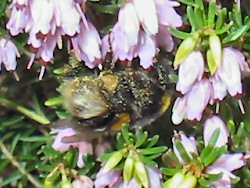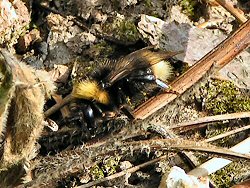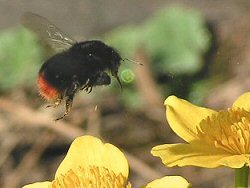| Features: Garden wildlife |  |
Winter-flying Bumblebees
I first noticed the occasional bumblebee flying in my garden on mild days during the winter of 2003/4, visiting winter-flowering shrubs. I was amazed. As a wildlife gardener I had recently been trying to learn more about bumblebees and had been reading everything I could find about them. This had not proved too difficult, as there are not many books about bumblebees. All the books said that bumblebee colonies died out in the late summer or early autumn, leaving solitary fertile females (queens) to find nooks and crannies under piles of dead vegetation or in the ground, where they would hibernate until they emerged the next spring to look for nest sites and found new colonies. And yet  I had the evidence of my own eyes, bumblebees avidly foraging for pollen and nectar in December and January, not just queens (who could have temporarily woken from hibernation) but smaller 'workers'. So what was going on? I had the evidence of my own eyes, bumblebees avidly foraging for pollen and nectar in December and January, not just queens (who could have temporarily woken from hibernation) but smaller 'workers'. So what was going on? I had the evidence of my own eyes, bumblebees avidly foraging for pollen and nectar in December and January, not just queens (who could have temporarily woken from hibernation) but smaller 'workers'. So what was going on? I had the evidence of my own eyes, bumblebees avidly foraging for pollen and nectar in December and January, not just queens (who could have temporarily woken from hibernation) but smaller 'workers'. So what was going on? Unravelling the mystery
I found my first clue when I came across a recent, excellent book called Bumblebees of Essex by Ted Benton. This book is well worth reading if you are interested in bumblebees, and you don't have to live in Essex to find it a useful source of information.
 This bumblebee (probably Bombus lucorum) was recorded in the garden on 5th Feburary.
The author commented that there was recent evidence that colonies of Bombus lucorum (white-tailed bumblebee) - one of the commonest species of garden bumblebee - appeared to persisting over winter in the far south of Essex. Well I live further south than that (in South London), and all the winter bees I had seen looked like B. lucorum, and so there was surely every chance that I was seeing the same phenomenon. Queens of B. lucorum have two yellow bands and a white tail, while queens of the closely related B. terrestris (buff-tailed bumblebee) have two yellow bands and a brownish tail. The workers of both species are almost identical, having two yellow bands and a white tail, although the yellow bands of B. lucorum tend to be clearer and more of a lemon-yellow. This bumblebee (probably Bombus lucorum) was recorded in the garden on 5th Feburary.
The author commented that there was recent evidence that colonies of Bombus lucorum (white-tailed bumblebee) - one of the commonest species of garden bumblebee - appeared to persisting over winter in the far south of Essex. Well I live further south than that (in South London), and all the winter bees I had seen looked like B. lucorum, and so there was surely every chance that I was seeing the same phenomenon. Queens of B. lucorum have two yellow bands and a white tail, while queens of the closely related B. terrestris (buff-tailed bumblebee) have two yellow bands and a brownish tail. The workers of both species are almost identical, having two yellow bands and a white tail, although the yellow bands of B. lucorum tend to be clearer and more of a lemon-yellow.
By making enquiries through various friends and contacts in wildlife organisations I have gradually found out what has been happening. It seems that  colonies of bumblebees have been occasionally observed persisting throughout the winter in sheltered places in the south of England and along the Western coast of England and Wales for many years colonies of bumblebees have been occasionally observed persisting throughout the winter in sheltered places in the south of England and along the Western coast of England and Wales for many years colonies of bumblebees have been occasionally observed persisting throughout the winter in sheltered places in the south of England and along the Western coast of England and Wales for many years. They are very much dependent on the nectar and pollen provided by winter-flowering shrubs in gardens, as hardly any native wild plants produce flowers in the winter. Such a winter colony was even observed in the Wildlife Garden at the Natural History Museum in London, where many of Britain's leading entomologists work. These winter colonies no longer seem to be restricted to southernmost counties, as this winter (2004/5) there have been reports from Shropshire and Leicestershire, and last winter I heard of a colony in a garden on the coast of North Wales. colonies of bumblebees have been occasionally observed persisting throughout the winter in sheltered places in the south of England and along the Western coast of England and Wales for many years. They are very much dependent on the nectar and pollen provided by winter-flowering shrubs in gardens, as hardly any native wild plants produce flowers in the winter. Such a winter colony was even observed in the Wildlife Garden at the Natural History Museum in London, where many of Britain's leading entomologists work. These winter colonies no longer seem to be restricted to southernmost counties, as this winter (2004/5) there have been reports from Shropshire and Leicestershire, and last winter I heard of a colony in a garden on the coast of North Wales.
Climatic adaptations
In fact bumblebees are much hardier than is often appreciated. Wild bumblebees are found well into the Arctic Circle. They are able to fly and look for food in lower temperatures than honey bees, which are not native to Britain and originated in Southern Asia, although domesticated and brought here by humans thousands of years ago.  Bumblebees' furry coats are an adaptation to cool weather, and they can also generate heat internally by vibrating muscles in their thorax Bumblebees' furry coats are an adaptation to cool weather, and they can also generate heat internally by vibrating muscles in their thorax Bumblebees' furry coats are an adaptation to cool weather, and they can also generate heat internally by vibrating muscles in their thorax. So they can fly and start foraging for nectar and pollen when air temperatures reach about 9 or 10 degrees Celsius. In spring and summer this allows bumblebees to compete successfully with honeybees for the same food resources, as bumblebees can fly earlier in the day and in cooler weather than can honeybees. Bumblebees' furry coats are an adaptation to cool weather, and they can also generate heat internally by vibrating muscles in their thorax. So they can fly and start foraging for nectar and pollen when air temperatures reach about 9 or 10 degrees Celsius. In spring and summer this allows bumblebees to compete successfully with honeybees for the same food resources, as bumblebees can fly earlier in the day and in cooler weather than can honeybees.
 The appearance of winter bumblebee colonies in Britain in recent years is surely a result of our much milder winters The appearance of winter bumblebee colonies in Britain in recent years is surely a result of our much milder winters The appearance of winter bumblebee colonies in Britain in recent years is surely a result of our much milder winters. This winter there have been many days in London where the ambient temperature exceeded 9 degrees, often reaching 12 degrees even in December and January. Insects in general are very sensitive to temperature changes, and being mobile and able to breed quickly, insect populations can respond to a warming climate by colonising new areas much faster than can plants or larger animals. This has been noticed in the case of the Comma, (Polygonia c-album) a beautiful garden and woodland butterfly whose population has been expanding northwards into Northern England and Scotland for a decade or more. The appearance of winter bumblebee colonies in Britain in recent years is surely a result of our much milder winters. This winter there have been many days in London where the ambient temperature exceeded 9 degrees, often reaching 12 degrees even in December and January. Insects in general are very sensitive to temperature changes, and being mobile and able to breed quickly, insect populations can respond to a warming climate by colonising new areas much faster than can plants or larger animals. This has been noticed in the case of the Comma, (Polygonia c-album) a beautiful garden and woodland butterfly whose population has been expanding northwards into Northern England and Scotland for a decade or more.
 Queen buff-tailed bumblebee (Bombus terrestris).
Another example is a small green cricket called the Long-winged Conehead (Conocephalus discolor), which was a national rarity found only within a mile or two of the South coast until the early 1990s, when it started to expand northwards. It produces a long-winged form that is able to fly and colonise new territory, and is very fond of dense herbaceous vegetation. Now it is all over the southern counties. The first sighting in London was in the mid 1990s, and last summer I found it in my garden for the first time. No doubt this species is also spreading north of London. Queen buff-tailed bumblebee (Bombus terrestris).
Another example is a small green cricket called the Long-winged Conehead (Conocephalus discolor), which was a national rarity found only within a mile or two of the South coast until the early 1990s, when it started to expand northwards. It produces a long-winged form that is able to fly and colonise new territory, and is very fond of dense herbaceous vegetation. Now it is all over the southern counties. The first sighting in London was in the mid 1990s, and last summer I found it in my garden for the first time. No doubt this species is also spreading north of London.
Bombus terrestris is used throughout temperate regions of the world as a pollinator in glasshouses were tomatoes are grown commercially. Colonies are raised in nestboxes which are placed in the glasshouses. It is conceivable that selective breeding of these bees in captivity for year-round pollination has produced a strain in which the hibernating instinct is reduced. Inevitably some escape from glasshouses through open doors. Could such bees be the origin of our winter bumblebee populations? Some scientific investigation has been undertaken, but so far results have apparently been inconclusive.
Winter bumblebees and the gardener
If you see any bumblebees this winter, or next winter, especially if you live in the Midlands or the North, your county wildlife trust will have a recorder for bees who may well be very interested in your sighting.
 Red-tailed bumblebee (Bombus lapidarius).
You need to record the date and location you saw it, and if you are not very familiar with bumblebee identification, try at least to confirm whether it has two yellow bands and a brownish or a white tail, (which means that it is Bombus terrestris or B. lucorum) or whether it has some other coat pattern. If it has an orange-red tail and no yellow bands, then it is probably Bombus lapidarius (red-tailed bumblebee). To my knowledge this species has not yet been found to be active in winter but its queens are often the first to emerge form hibernation in March or April. It would be interesting if it were modifying its behaviour by emerging from hibernation earlier. If you sight this handsome species in winter you could be making a first record for the UK and you should most definitely contact your county recorder. The National Phenology Network, supported by the Woodland Trust, is also recording bumblebee sightings by the general public and you can report winter or early spring bumblebees to them through their website at www.phenology.org.uk. Red-tailed bumblebee (Bombus lapidarius).
You need to record the date and location you saw it, and if you are not very familiar with bumblebee identification, try at least to confirm whether it has two yellow bands and a brownish or a white tail, (which means that it is Bombus terrestris or B. lucorum) or whether it has some other coat pattern. If it has an orange-red tail and no yellow bands, then it is probably Bombus lapidarius (red-tailed bumblebee). To my knowledge this species has not yet been found to be active in winter but its queens are often the first to emerge form hibernation in March or April. It would be interesting if it were modifying its behaviour by emerging from hibernation earlier. If you sight this handsome species in winter you could be making a first record for the UK and you should most definitely contact your county recorder. The National Phenology Network, supported by the Woodland Trust, is also recording bumblebee sightings by the general public and you can report winter or early spring bumblebees to them through their website at www.phenology.org.uk.
The  winter flowering plants that I have noticed most frequently attracting bees are Mahonias such a M. 'Charity', winter-flowering heathers (forms of Erica carnea), and Lonicera x purpusii winter flowering plants that I have noticed most frequently attracting bees are Mahonias such a M. 'Charity', winter-flowering heathers (forms of Erica carnea), and Lonicera x purpusii winter flowering plants that I have noticed most frequently attracting bees are Mahonias such a M. 'Charity', winter-flowering heathers (forms of Erica carnea), and Lonicera x purpusii, a shrubby winter- flowering honeysuckle with strongly scented small white flowers, produced over a long period from winter into spring. This Lonicera is a good plant for wildlife gardens as its flowers are a magnet for early bees. winter flowering plants that I have noticed most frequently attracting bees are Mahonias such a M. 'Charity', winter-flowering heathers (forms of Erica carnea), and Lonicera x purpusii, a shrubby winter- flowering honeysuckle with strongly scented small white flowers, produced over a long period from winter into spring. This Lonicera is a good plant for wildlife gardens as its flowers are a magnet for early bees.
The phenomenon of winter bumblebee colonies is an interesting example of a native insect species exploiting 'exotic' garden plants, and shows how in special circumstances gardens can be a better food source for wildlife than the wider countryside.
| First published February 2005. | |
Copyright Marc Carlton 2005. Permission is hereby granted for anyone to use this article for non-commercial purposes which are of benefit to the natural environment as long the original author is credited. School pupils, students, teachers and educators are invited to use the article freely. Use for commercial purposes is prohibited unless permission is obtained from the copyright holder. |
Back to home page
Do you live in Merseyside? Interested in its wildlife? | |